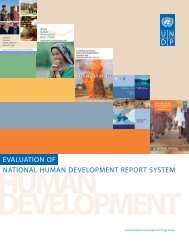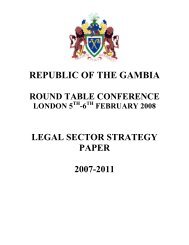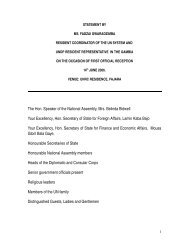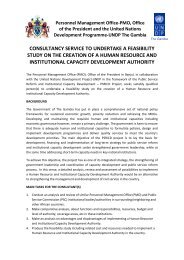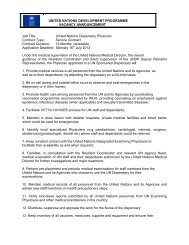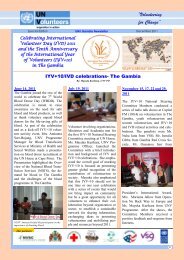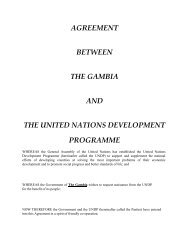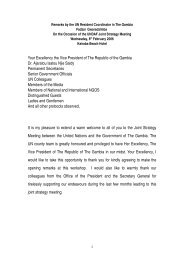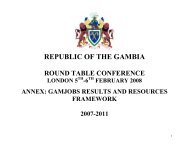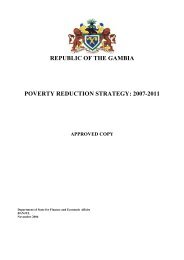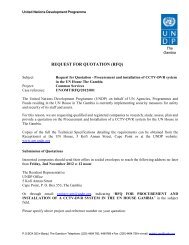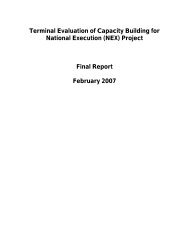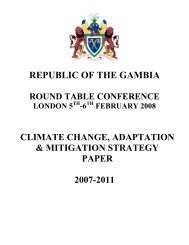Introduction - UNDP The Gambia
Introduction - UNDP The Gambia
Introduction - UNDP The Gambia
Create successful ePaper yourself
Turn your PDF publications into a flip-book with our unique Google optimized e-Paper software.
________________________________________________________________________________________________________________________<br />
founding family. For example, in the<br />
Manding dynasty, like in all other ethnic<br />
dynasties, the kabilo is an expression of<br />
kinship lineage, with the head of the kabilo<br />
called kabila tio or kabila keeba. Resources<br />
for productive activity are centred on the<br />
kabilo production system.<br />
<strong>The</strong> core of the kabilo is a patrilineal kin<br />
group, but the kabilo frequently accommodate<br />
temporary residents and permanent<br />
compounds not related to the patrilineage,<br />
based on a history of longstanding patronage<br />
between founders (jatiyolu) and newcomers<br />
(luntangolu).<br />
<strong>The</strong> ward of the founding patrilineage has a<br />
central position of authority and prestige in<br />
the village. Men and women and other<br />
productive resources are mobilised through<br />
the patrilineal extended family group for<br />
community participation.<br />
<strong>The</strong> Chieftaincy: <strong>The</strong> chieftaincy is the<br />
highest traditional political structure in <strong>The</strong><br />
<strong>Gambia</strong>. It was of prime importance during<br />
the colonial era. <strong>The</strong> chieftaincy was<br />
introduced by the colonial administration,<br />
which improved on the existing social<br />
arrangements of which the village heads were<br />
the highest decision- makers. <strong>The</strong> structure<br />
can be compared to the Ghanaian House of<br />
Chiefs, the emirate and caliphate in northern<br />
Nigeria.<br />
<strong>The</strong> chief, as earlier mentioned, is responsible<br />
for a district, which consists of several<br />
villages constituting a constituency. He or she<br />
oversees the administration of such villages,<br />
through the alkaloolu, who are responsible<br />
for the day-to-day administration of their<br />
communities and report back to the chief.<br />
Since the colonial period, the chieftaincy has<br />
played crucial roles in the governance and<br />
administration of communities and has<br />
always been the point of reference for<br />
community development in the rural<br />
areas. <strong>The</strong> structure is the highest decisionmaking<br />
body at the district level which filters<br />
through alkaloolu in the villages and also<br />
commands respect, power and authority.<br />
Apart from being the point of reference,<br />
chiefs mediate in the implementation of<br />
justice and peace. <strong>The</strong>ir role includes<br />
litigation, arbitration, mediation and conflict<br />
resolution. During the colonial period, these<br />
roles were further enhanced to suit the<br />
colonialist projects. Chiefs were considered to<br />
be intermediaries between the colonial<br />
masters and their subjects. <strong>The</strong>y also form the<br />
hegemony within the community and families<br />
and kin groups refer to them for all family<br />
issues related to the kinship. <strong>The</strong> missionaries<br />
used the chiefs to achieve their objectives; the<br />
results can be seen throughout the continent.<br />
For instance, in <strong>The</strong> <strong>Gambia</strong>, the chiefs were<br />
used to collect hut taxes and levy charges on<br />
the polity. In this way, they were paid salaries<br />
and engaged in wage labour. <strong>The</strong>se new<br />
responsibilities enhanced the status of the<br />
chiefs. <strong>The</strong>y were mandated to appoint court<br />
clerks and konsingbalo 6 (badge messengers),<br />
thus enhancing their status economically and<br />
socially. 7<br />
Council of Elders: Similarly, the Council of<br />
Elders is part of the traditional structure and<br />
constitutes ano ther decision-making body in<br />
the community. <strong>The</strong> elders are usually drawn<br />
from the heads of the kabilo. In other words,<br />
all the heads of the kabilo (kabila keeba) are<br />
members of the Council of Elders including<br />
the alkalo. <strong>The</strong>y take decisions on the<br />
management of resources within the<br />
community.<br />
<strong>The</strong> positions of alkaloship and Council of<br />
Elders are highly patrimonial and tend to<br />
take women’s concerns for granted. However,<br />
gender disparity can be an obstacle to the<br />
achievement of <strong>The</strong> <strong>Gambia</strong>’s development<br />
goals as stated in the MDGs, Vision 2020 and<br />
SPA II. Table 12 is an indication of the<br />
gender disparity in the structure.<br />
________________________________________________________________________________________________<br />
Building Capacity for the Attainment of the Millennium Development Goals in <strong>The</strong> <strong>Gambia</strong> National Human Development Report 2005<br />
52




